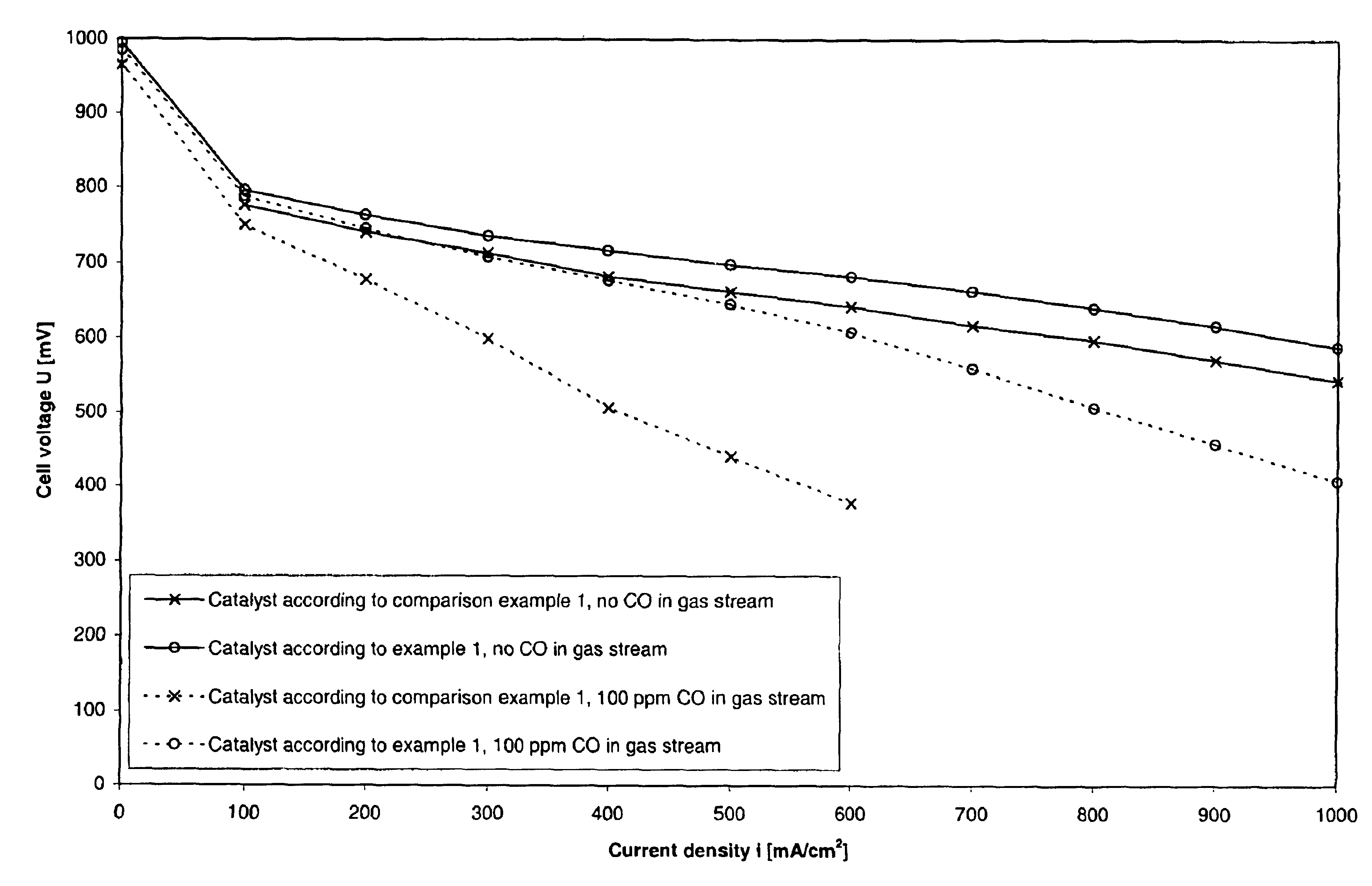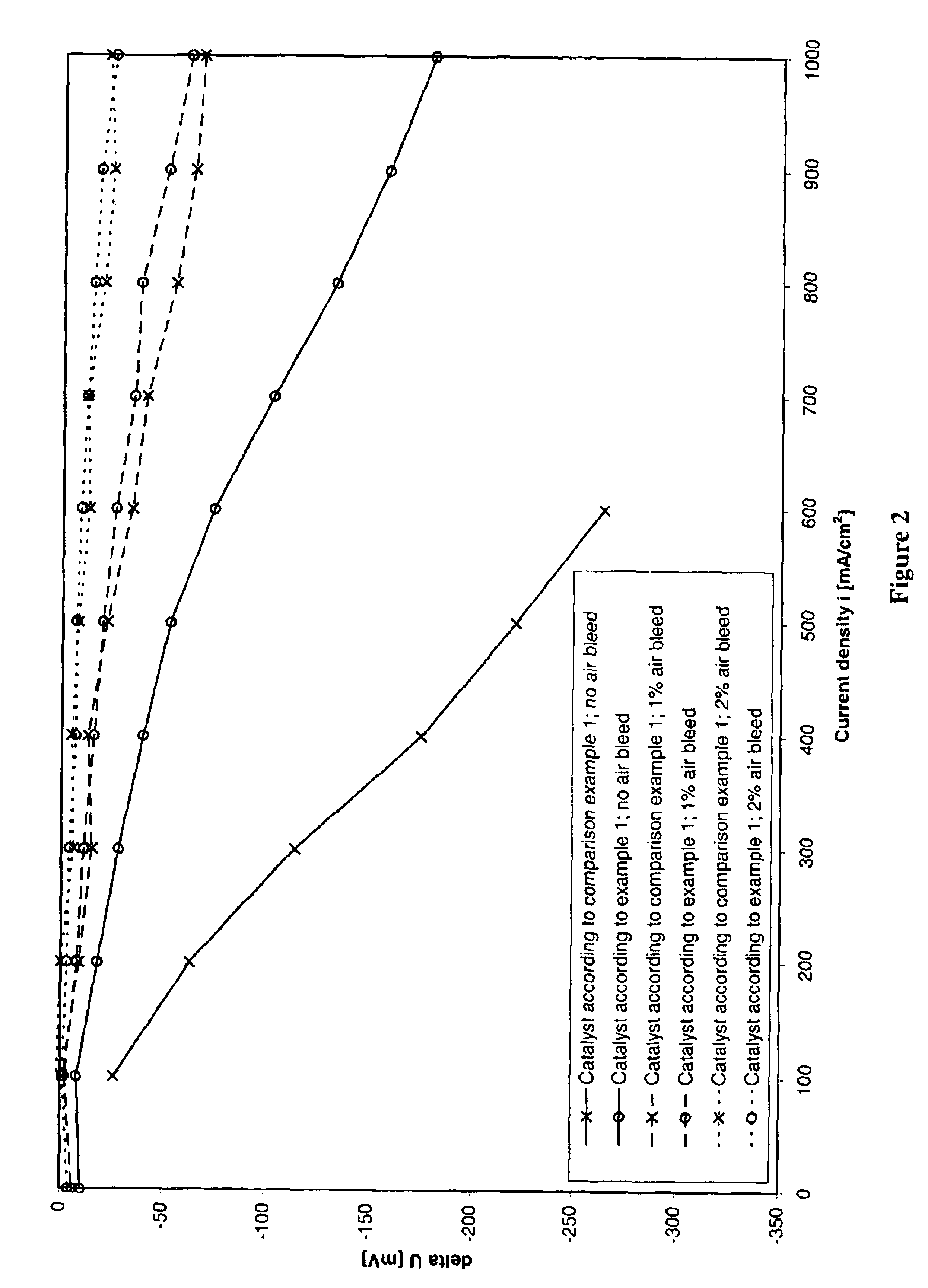Process for preparing an anode catalyst for fuel cells and the anode catalyst prepared therewith
a fuel cell and anode catalyst technology, applied in the direction of catalyst activation/preparation, metal/metal-oxide/metal-hydroxide catalysts, etc., can solve the problems of high cost of hydrogen, poor reaction efficiency, and high toxicity of traditional platinum catalysts, so as to improve the quality of the reduction process and high activity , the effect of high tolerance to carbon monoxid
- Summary
- Abstract
- Description
- Claims
- Application Information
AI Technical Summary
Benefits of technology
Problems solved by technology
Method used
Image
Examples
example 1
30 g of carbon black (Vulcan XC 72) were suspended in 1.5 l of fully deionised water (VE water) for 30 minutes at room temperature. 52.7 g of 25% strength hexachloroplatinic (IV) acid and 29.4 g of 23.2% strength ruthenium (III) chloride solution were diluted to 300 ml with fully deionised water (VE water) and added to the suspension. The suspension was heated to 80.degree. C. Then the pH was increased to 7.0 using caustic soda solution.
After intensive stirring, 320 ml of dipotassium tartrate hemihydrate solution (Merck, Darmstadt, concentration 0.1 mol / l) were added to the suspension. The pH was kept constant by the further addition of caustic soda solution. Then 56 ml of 24% strength hydrazine solution were added and the suspension was stirred again. Then the catalyst was filtered off and dried at elevated temperature. Finally, the catalyst was calcined at 500.degree. C. under nitrogen.
The final catalyst had a noble metal loading of 40 wt.-%, with respect to the total weight, and ...
example 2
To prepare a catalyst with a noble metal loading of 60 wt.-%, example 1 was repeated, but only 13.3 g of carbon black were suspended in water in order to obtain a higher loading.
The final catalyst had a noble metal loading of 60 wt.-%, with respect to the total weight, and an atomic ratio Pt / Ru of 1:1. Characterisation of the catalyst using XRD and XPS gave the following values:
example 3
To prepare an unsupported platinum-ruthenium catalyst (platinum-ruthenium black), the following procedure was used:
52.7 g of 25% strength hexachloroplatinic(IV) acid and 29.4 g of 23.2% strength ruthenium (III) chloride solution were added to 1.8 l of fully deionised water (VE water) and the solution was heated to 80.degree. C. Then, the pH was increased to 7.0 using caustic soda solution.
After intensive stirring for a period of 1.5 hours, 320 ml of dipotassium tartrate hemihydrate solution (Merck, Darmstadt, concentration 0.1 mol / l) were added. The pH was kept constant by the further addition of caustic soda solution. Then 56 ml of 24% strength hydrazine solution were added and the suspension was stirred further. Then the catalyst was filtered off and dried at elevated temperature.
Characterisation of the catalyst using XPS and XRD gave the following values:
PUM
| Property | Measurement | Unit |
|---|---|---|
| bonding energy | aaaaa | aaaaa |
| particle size | aaaaa | aaaaa |
| temperatures | aaaaa | aaaaa |
Abstract
Description
Claims
Application Information
 Login to View More
Login to View More - R&D
- Intellectual Property
- Life Sciences
- Materials
- Tech Scout
- Unparalleled Data Quality
- Higher Quality Content
- 60% Fewer Hallucinations
Browse by: Latest US Patents, China's latest patents, Technical Efficacy Thesaurus, Application Domain, Technology Topic, Popular Technical Reports.
© 2025 PatSnap. All rights reserved.Legal|Privacy policy|Modern Slavery Act Transparency Statement|Sitemap|About US| Contact US: help@patsnap.com



